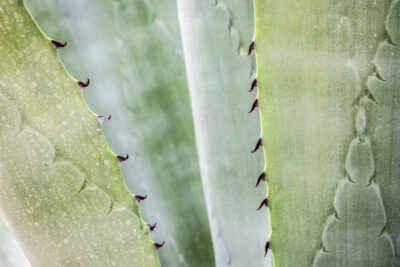
Step-by-Step Guide: How to Prune a Succulent Plant for Optimal Growth

Succulent plants have gained immense popularity in recent years due to their unique and diverse shapes, colors, and textures. These plants, known for their ability to store water in their leaves and stems, require specific care and maintenance to ensure their optimal growth and health. One crucial aspect of succulent plant care is pruning. Pruning helps to promote new growth, maintain the plant's shape, and prevent diseases or pests from spreading.
We will provide you with a step-by-step guide on how to prune a succulent plant for optimal growth. We will cover the tools you will need, the best time to prune, and the different types of pruning techniques. Additionally, we will discuss the importance of removing dead or damaged leaves, how to encourage branching, and how to propagate succulent cuttings. By following our instructions, you will be able to successfully prune your succulent plants and promote healthy growth and longevity.
- Use clean and sharp pruning shears to prevent damage to the plant
- Cut off any dead or damaged leaves or stems to promote new growth
- Remove any leggy or stretched-out branches to maintain a compact shape
- Trim back overgrown branches to encourage branching and a fuller appearance
- Make clean cuts at a 45-degree angle to prevent water from pooling on the wound
- Allow the cut ends to dry for a few days before replanting or propagating
- Consider repotting the succulent after pruning to provide fresh soil and nutrients
- Provide the plant with adequate sunlight, water, and drainage for optimal growth
- Monitor the plant for any signs of disease or pests and take appropriate action
- Frequently Asked Questions
Use clean and sharp pruning shears to prevent damage to the plant
When it comes to pruning succulent plants, using clean and sharp pruning shears is essential. This not only helps in preventing damage to the plant but also promotes optimal growth. Dirty or dull shears can introduce bacteria or fungi to the plant, which can lead to infections or diseases.
Before you begin pruning, make sure to sanitize your pruning shears. You can do this by wiping the blades with rubbing alcohol or a mixture of bleach and water. This will help eliminate any potential pathogens that may harm the plant.
Identify the areas that need pruning
Take a close look at your succulent plant and identify the areas that require pruning. Look for any dead, damaged, or diseased leaves or stems. These can hinder the growth of the plant and should be removed to promote healthier growth.
Additionally, look for any overcrowded areas or leggy stems that may be taking away from the plant's overall appearance. Pruning these areas will help maintain a compact and aesthetically pleasing shape.
Understand the different pruning techniques
There are two main pruning techniques that you can use for succulent plants:
 Protecting Succulents in Cold Weather: How Much Cold Can They Handle?
Protecting Succulents in Cold Weather: How Much Cold Can They Handle?- Pinching: This technique involves using your fingers or thumb to pinch off the unwanted growth. Pinching is ideal for removing small leaves, shoots, or buds.
- Snipping: Snipping involves using your pruning shears to cut away larger stems or branches. This technique is suitable for removing larger sections of the plant that may be overgrown or damaged.
Understanding these techniques will help you determine the appropriate method to use for each pruning situation.
Prune with precision
When you start pruning, remember to do so with precision. Carefully remove the selected leaves, stems, or branches without causing any damage to the rest of the plant. Make clean and precise cuts to promote faster healing and prevent any unnecessary stress to the plant.
It's important to note that succulent plants have the capability to regenerate from the remaining stem or leaf. So, make sure to prune just above a node or joint to encourage new growth from that point.
After pruning, you can apply a mild fungicide or rubbing alcohol to the cut areas to prevent any potential infections. This step is especially crucial if you have pruned any diseased parts of the plant.
Remember, pruning is not a one-time process. Regularly check your succulent plant for any new growth, damaged parts, or overcrowding, and prune as needed. By following these step-by-step pruning guidelines, you can ensure optimal growth and keep your succulent plant healthy and thriving.
Cut off any dead or damaged leaves or stems to promote new growth
Pruning is an essential task in maintaining the health and appearance of your succulent plants. By removing dead or damaged leaves and stems, you create space for new growth and prevent the risk of disease or pest infestation. Follow these step-by-step instructions to prune your succulent plants effectively:
 Expert Tips for Thriving Succulents: Assessing Plant Health
Expert Tips for Thriving Succulents: Assessing Plant Health- Inspect your succulent: Before starting the pruning process, carefully examine your succulent plant. Identify any leaves or stems that are discolored, wilted, or damaged. These are the areas that need to be pruned.
- Gather the necessary tools: To prune your succulent, you will need a pair of clean, sharp scissors or pruning shears. Make sure the tools are sanitized to avoid any potential transfer of diseases or infections.
- Locate the target: Focus on the specific leaves or stems that require pruning. They may be at the base of the plant or towards the top. Look for signs of rot, discoloration, or shriveling.
- Trim the dead/damaged parts: Carefully cut off the dead or damaged leaves or stems. Make sure to cut them as close to the base as possible, without harming the healthy parts of the plant. This will encourage new growth in the remaining healthy sections.
- Dispose of the pruned parts: After pruning, it is essential to properly dispose of the removed leaves and stems. Discard them in a sealed bag or container to prevent any potential spread of diseases or pests.
- Monitor and care for your succulent: Once you have pruned your succulent, keep a close eye on its progress. Provide adequate sunlight, water, and proper care to ensure optimal growth.
Remember, pruning should be done with caution and only when necessary. Avoid over-pruning, as it can stress the plant or hinder its growth. Regularly inspect your succulent plants for any signs of damage or disease, and promptly address them through appropriate pruning techniques.
Remove any leggy or stretched-out branches to maintain a compact shape
One of the most important steps in pruning a succulent plant is to remove any leggy or stretched-out branches. This helps to maintain a compact shape and encourages optimal growth. Leggy branches can occur when a succulent doesn't receive enough sunlight or when it grows in low-light conditions.
To prune a succulent, start by identifying the leggy branches that need to be removed. These branches are usually longer and thinner than the rest of the plant. Using a pair of clean, sharp scissors or pruning shears, carefully cut the leggy branches near the base of the plant.
It's important to use clean and sharp tools to prevent any damage or infection to the plant. You can sterilize your scissors or pruning shears by wiping them with rubbing alcohol before making any cuts.
Once you have removed the leggy branches, you can consider propagating them to create new succulent plants. Simply let the cut ends of the branches dry for a few days, and then place them in well-draining soil. Keep the soil slightly moist and provide indirect sunlight until new roots start to form.
Remember to always remove leggy branches during the active growing season of the succulent, which is typically in spring or summer. Pruning during this time allows the plant to recover more quickly and encourages new growth.
 Challenging Succulents: Types that Require Extra Care to Thrive
Challenging Succulents: Types that Require Extra Care to ThriveSummary:
- Identify leggy or stretched-out branches
- Cut the leggy branches near the base of the plant
- Use clean and sharp scissors or pruning shears
- Sterilize tools with rubbing alcohol
- Consider propagating the removed branches
- Remove leggy branches during the active growing season
By following these steps, you can effectively prune your succulent plant to maintain a compact shape and promote optimal growth. Remember to always care for your succulent by providing adequate sunlight, well-draining soil, and appropriate watering to ensure its overall health and vitality.
Trim back overgrown branches to encourage branching and a fuller appearance
Pruning your succulent plants is an essential practice to ensure their optimal growth and overall health. By trimming back overgrown branches, you not only promote branching but also achieve a fuller and more visually appealing appearance for your plants.
Wondering how to prune your succulent plant effectively? Follow our step-by-step guide below:
Step 1: Gather the necessary tools
- Pruning shears: Choose a pair of sharp pruning shears specifically designed for cutting through succulent stems.
- Gloves: Wear gloves to protect your hands from any prickly or sharp parts of the plant.
- Disinfectant: Prepare a solution of disinfectant or rubbing alcohol to sterilize your pruning shears before and after each use.
Step 2: Identify the branches to be pruned
Inspect your succulent plant and look for any branches that have grown excessively long or are damaged. These are the branches that you should focus on pruning.
Step 3: Make clean cuts
Using your pruning shears, make clean cuts just above the leaf node or joint. This will encourage new growth and prevent any unsightly stubs from forming.
 The Proper Depth for Planting Succulents in the Ground: A Guide
The Proper Depth for Planting Succulents in the Ground: A GuideStep 4: Remove any dead or diseased parts
If you come across any dead or diseased branches or leaves, remove them completely to prevent the spread of infection to the rest of the plant.
Step 5: Allow the cuttings to dry
After pruning, allow the cuttings to dry for a few days before replanting or propagating. This will help prevent rotting and ensure successful rooting.
Step 6: Dispose of the pruned branches properly
Dispose of the pruned branches in a compost bin or dispose of them in an environmentally friendly manner. Do not leave them lying around, as they can attract pests or diseases.
By following these simple steps, you can effectively prune your succulent plant and promote its optimal growth and appearance. Remember, regular pruning is key to maintaining the health and beauty of your succulents!
Make clean cuts at a 45-degree angle to prevent water from pooling on the wound
Introduction:
Pruning is an essential practice for maintaining the health and appearance of your succulent plants. By removing dead or overgrown parts, you can stimulate new growth and prevent disease or pest infestations. In this step-by-step guide, we will walk you through the process of pruning a succulent plant for optimal growth.
Step 1: Gather your tools
Before you start pruning, it's important to have the right tools on hand. You will need a pair of clean and sharp pruning shears or scissors, a clean cloth or paper towel, and rubbing alcohol. Ensuring your tools are clean helps prevent the spread of any potential diseases or infections.
Step 2: Identify what needs to be pruned
Take a close look at your succulent plant and identify any dead, damaged, or overgrown parts. These can include yellowing or discolored leaves, shriveled stems, or branches that are crowding the plant's overall structure. It's crucial to remove these parts to promote healthier growth.
 How frequently should I apply Miracle-Gro Succulent Plant Food?
How frequently should I apply Miracle-Gro Succulent Plant Food?Step 3: Prepare for pruning
Before making any cuts, gently wipe down your pruning shears or scissors with rubbing alcohol to sterilize them. This step helps prevent the spread of any potential pathogens between plants. Additionally, prepare a clean, dry cloth or paper towel to wipe away any sap or debris that may accumulate during the pruning process.
Step 4: Make clean cuts
When making cuts on your succulent plant, aim for a 45-degree angle. This angle prevents water from pooling on the wound, reducing the risk of rot or fungal infections. Make sure your cuts are clean and precise, avoiding any tearing or jagged edges. This promotes faster healing and minimizes stress on the plant.
Step 5: Remove dead or overgrown parts
Start by removing any dead or damaged leaves or stems. These can be easily identified by their discoloration or lack of firmness. Gently grasp the base of the leaf or stem you want to remove and make a clean cut at the desired location. Be cautious not to damage any healthy parts of the plant during this process.
Step 6: Maintain a balanced shape
If your succulent plant has become overgrown or has branches that are crowding its overall shape, it's important to restore balance. Identify the branches that are causing imbalance and carefully remove them, maintaining the plant's desired shape. Remember to make clean cuts at a 45-degree angle.
Step 7: Dispose of pruned parts
After pruning, it's crucial to properly dispose of the pruned parts. Dead or overgrown plant material can harbor pests or diseases, so it's best to remove them from your garden or compost pile. Seal them in a plastic bag and dispose of them in the trash or follow local waste disposal guidelines.
Conclusion:
Pruning your succulent plants is a simple yet crucial step in ensuring their optimal growth and overall health. By following this step-by-step guide, you can confidently prune your succulents, stimulating new growth and maintaining their beautiful appearance. Remember to always make clean cuts at a 45-degree angle and dispose of pruned parts properly. Happy pruning!
Allow the cut ends to dry for a few days before replanting or propagating
 Watering Succulents After Repotting: What You Need to Know
Watering Succulents After Repotting: What You Need to KnowAfter pruning your succulent plant, it is essential to allow the cut ends to dry out before taking any further steps. This drying period is crucial as it helps prevent the cut ends from becoming vulnerable to rot and disease.
To begin, make sure you have a clean and dry surface ready for the cut ends to rest on. Find a well-ventilated area with indirect sunlight to place your pruned succulent. Avoid direct sunlight as it may cause the cut ends to dry too quickly, leading to potential damage.
Once you have chosen the ideal location, carefully place the pruned succulent on the surface, ensuring that the cut ends are exposed to the air. It is crucial not to cover or bury the cut ends during this drying period.
Allow the cut ends to dry for approximately two to three days. The exact duration may vary depending on the thickness of the cuts and the environmental conditions. During this time, you may notice that the cut ends develop a calloused layer, which is a natural part of the healing process.
Note: It is important to refrain from watering the succulent during the drying period. Moisture can hinder the healing process and potentially lead to rotting of the cut ends. Ensure that the succulent remains dry throughout this stage.
Once the cut ends have completely dried and formed a calloused layer, you can proceed with replanting or propagating your succulent. This step ensures that the plant is ready for its new growth phase and minimizes the risk of any infections or diseases.
Consider repotting the succulent after pruning to provide fresh soil and nutrients
 Succulent Care: A Guide to Cliff Cotyledon and Crassulaceae
Succulent Care: A Guide to Cliff Cotyledon and CrassulaceaeWhen it comes to pruning a succulent plant, it's important to consider repotting it afterwards. Repotting provides the succulent with fresh soil and nutrients, which are essential for its optimal growth and overall health.
Follow these simple steps to repot your succulent after pruning:
- Choose the right pot: Select a pot that is slightly larger than the current one, allowing the succulent's roots to have room to grow. Ensure that the pot has drainage holes to prevent water from pooling and causing root rot.
- Prepare the new soil: Use a well-draining soil mix specifically designed for succulents. You can also create your own mix by combining equal parts of potting soil, perlite, and coarse sand. This will provide the succulent with the right amount of moisture and aeration.
- Remove the succulent from its current pot: Gently tap the sides of the pot to loosen the soil. Carefully lift the succulent out, supporting the base of the plant. If the roots are tightly bound, you can lightly tease them apart to encourage new growth.
- Clean the roots: Inspect the roots for any signs of rot or damage. Trim away any unhealthy roots using clean, sterile pruning shears. Be careful not to cut too much as it can harm the plant.
- Place the succulent in the new pot: Fill the new pot with a layer of fresh soil, creating a mound in the center. Gently place the succulent on top, ensuring that it is centered and upright. Gradually fill the remaining space with soil, pressing it lightly to stabilize the plant.
- Water and settle the soil: After repotting, give the succulent a thorough watering, allowing the excess water to drain out. This will help settle the soil and eliminate any air pockets around the roots. Avoid watering again for a few days to allow the plant to adjust to its new environment.
- Provide proper care: Place the repotted succulent in a location with bright, indirect sunlight. Avoid placing it in direct sunlight, as it can cause sunburn. Water the succulent only when the soil is completely dry, and be careful not to overwater as it can lead to root rot.
By repotting your succulent after pruning, you are giving it a fresh start and ensuring that it has the necessary resources to thrive. Remember to monitor its growth and adjust your care routine accordingly. With proper pruning and repotting, your succulent will continue to flourish and bring joy to your space.
Provide the plant with adequate sunlight, water, and drainage for optimal growth
In order to ensure the optimal growth and health of your succulent plant, it is important to provide it with the right conditions. The three key factors to focus on are sunlight, water, and drainage.
Sunlight:
Succulents thrive in bright sunlight, so it is crucial to place them in an area where they can receive at least 6 hours of direct sunlight each day. You can keep them indoors near a sunny window or outdoors in a spot with ample sunlight. If you notice that your succulent is stretching or leaning towards the light, it is an indication that it needs more sunlight.
Water:
One common mistake when caring for succulents is overwatering. Succulents are adapted to survive in arid conditions and have the ability to store water in their leaves and stems. They prefer to be underwatered rather than overwatered. As a general rule, allow the soil to dry out completely between waterings. When watering, make sure to thoroughly soak the soil and then let it drain completely. Avoid leaving the plant sitting in standing water, as this can lead to root rot.
 Can Succulents Be Revived After Drying Out?
Can Succulents Be Revived After Drying Out?Drainage:
Proper drainage is crucial for the health of succulent plants. They are susceptible to root rot if their roots sit in waterlogged soil for an extended period of time. When planting or repotting your succulent, make sure to use a well-draining soil mix specifically formulated for succulents. Additionally, ensure that the pot has drainage holes to allow excess water to escape. If you are using a decorative pot without drainage holes, consider using a layer of gravel or pebbles at the bottom to create a drainage space.
By providing your succulent plant with adequate sunlight, water, and proper drainage, you are setting the foundation for optimal growth and long-term health.
Monitor the plant for any signs of disease or pests and take appropriate action
Keeping a close eye on your succulent plant is crucial for maintaining its optimal growth. Regularly inspect the plant for any signs of disease or pests that may be hindering its health. Look out for symptoms such as discoloration, wilting, spots, or unusual growth patterns.
If you notice any issues, it's important to take immediate action to prevent further damage. Remove any affected leaves or stems using clean pruning shears, making sure to cut them close to the base of the plant. Dispose of the infected parts properly to avoid spreading the disease.
Note: Always sanitize your pruning tools before and after each use to minimize the risk of introducing pathogens to your succulent.
Frequently Asked Questions
1. Why should I prune my succulent plant?
Pruning helps promote healthy growth, removes dead or damaged parts, and improves the overall appearance of the plant.
 Can Repotting Revive a Dead Succulent?
Can Repotting Revive a Dead Succulent?2. When is the best time to prune my succulent?
It is best to prune your succulent during its active growth period, which is typically in the spring or early summer.
3. How much should I prune off my succulent?
When pruning, aim to remove no more than one-third of the plant's total size to avoid shock and encourage regrowth.
4. How do I prune my succulent plant?
Use clean, sharp pruning shears to make clean cuts just above a leaf node or stem joint. Remove any dead or yellowing leaves, as well as any leggy or overgrown stems.
If you want to read more articles similar to Step-by-Step Guide: How to Prune a Succulent Plant for Optimal Growth, you can visit the Care and Maintenance category.






You Must Read